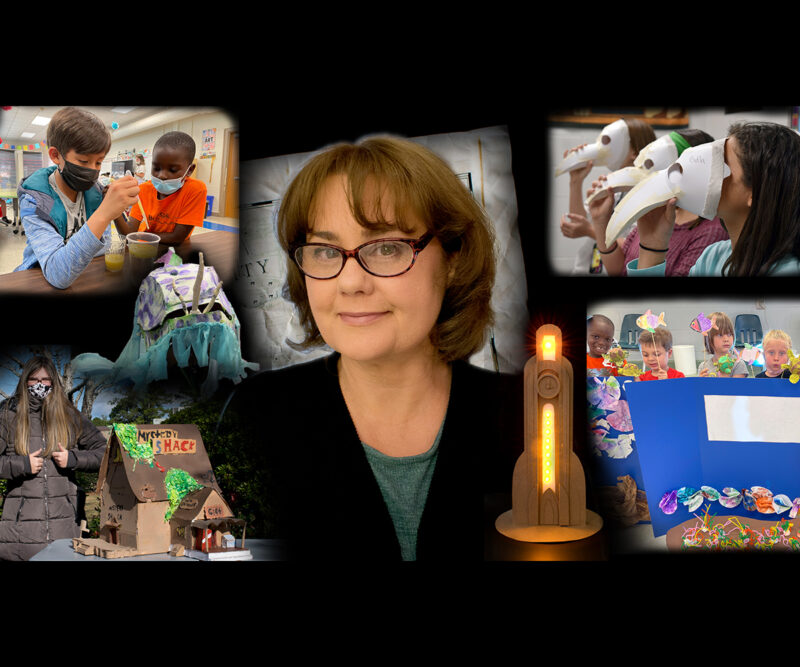Arts Directory
Gina Bean
INDIVIDUAL - SCAD ID - #103

Contact
ginabeanarts@yahoo.com
Berkeley County, SC
Discipline
- • Visual Art
- • Photography
Geographical Availability
- Upstate
- Midlands
- PeeDee/ Grand Strand
- Low Country
- Western Piedmont
- Olde English
About
Artist Bio
Gina Bean is a versatile mixed media and photography artist. As a Certified Teaching Artist with training and years of experience in arts integration best methods and practices, she customizes each residency for each school, based on teacher-chosen standards, objectives and preferences. She uses photography as either the focal point or a component combined with mixed media visual arts. Her focus is on the art side of photography rather than the tech side.
In the classroom, she often uses paper products, lightweight airdry clays, upcycled items, and a variety of materials to teach 3D art forms. Finished pieces may include interactive models, puppets/creatures, as well as paper and airdry clay sculptures, to make learning interactive and memorable for all grade levels.
In the classroom, photography is a useful tool for teaching just about any standard. It provides students with a documented record of learning, and aids in reflection. It can also give parents a glimpse into the classroom through shared digital files.
Photography, combined with mixed media visual arts, is a great tool for teaching design and visual arts principles of color theory, composition, texture, the same concepts that apply to drawing and painting. It is a natural fit for teaching science properties of light.
Just a few examples from recent residencies:
- World culture studies through puppetry – visual arts creation of props, staging and puppets and theater improvisation inspired by traditional world puppetry forms. This is a great intro to performing and public speaking as students get to hide behind puppets.
- Science studies of animals and their habitats through paper sculpture, airdry clay and other simple materials
- Landforms, seascapes, Earth’s rotation, and simple machines through creating interactive 3D models
- Math scale and formulas through building architectural scale models
- Properties of light through shadow puppetry
- Thermal energy through culinary arts and food styling, composition and photography – these students used convection, conduction, and radiation to cook their own food (safety and sanitation per dhec standards). They worked in groups with one student per group receiving signed permission to use their personal phones to capture images.
- Geographical time scales through stop motion photography. Students worked in groups; some used their personal phones and others used devices available in the school. They created simple paper and clay pieces to show a little piece of the science and history of our planet. Then they got to watch everybody’s videos with teacher-guided classroom reflection.
- Quadrilateral hierarchy through stop motion photography and very cute short stories. Students used paper and shot their stop motion pieces overhead. They learned all about the properties of quadrilaterals through their own very creative stories. Teachers checked out a few tablets from their library for filming.
- SFX Prosthetics and Makeup – In this after school program, we used photography to capture their looks. Students were focused on creating pieces and then posed (statue, tableau) for photos. Now they have their photo memories along with all the new skills they developed in the process.
Artist Statement
In my view, and my classes, weird is good. Different is good. Anything that makes us curious and provokes thought is also a good thing. I love all art but have an affinity for surrealism. Technique is important, but I am more fascinated by how composition, line, form, color, and texture spark imagination and ideas.
In the classroom, I teach students to use simple materials and methods to express themselves, as well as the standards they are learning. Providing choices and freedom reduces anxiety about learning new things. It’s okay to “mess up” art because we can always do a little problem solving and recreate it. Although I have worked in this field for many years, I continue to be amazed at ideas and creations that come from children. This usually means they are creating memories and making new connections to standards.
Personally, I treat my own work like sandcastles, never saving anything, so I can keep creating purely for joy. Though mostly self-taught, I have some formal art education, but my degree is in culinary arts and sports and health nutrition, and I love using food as art as well. Photography has always been a favorite. I am more drawn to light, shadow, composition, the artistic side of photography, than technical aspects.
It is important to me that all students benefit optimally from my time with them. I am not formally trained to work with special needs students, but with many neurodivergent brains in my own family, including ADHD and Autism, I understand the need for flexibility and accommodation. I rely on teachers’ insights and cues to ensure all students, regardless of their unique abilities, have a meaningful and enjoyable experience. I have found that what benefits special needs students often enhances the experience for all.